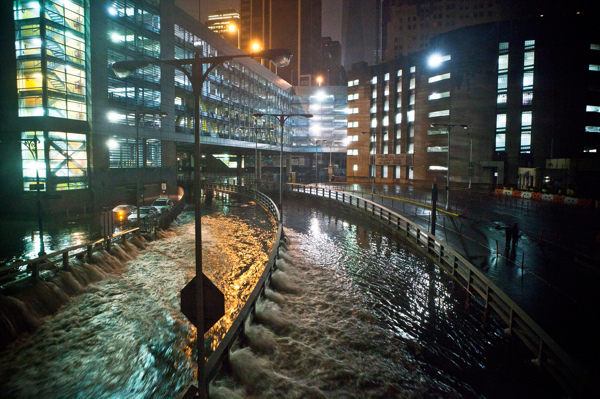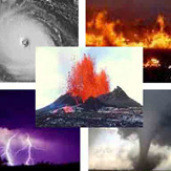
Flooding is a temporary overflow of water onto land that is normally dry. Floods are the most common natural disaster in the United States. Failing to evacuate flooded areas or entering flood waters can lead to injury or death.
Floods may:
- Result from rain, snow, coastal storms, storm surges and overflows of dams and other water systems.
- Develop slowly or quickly. Flash floods can come with no warning.
- Cause outages, disrupt transportation, damage buildings and create landslides.
IF YOU ARE UNDER A FLOOD WARNING, FIND SAFE SHELTER RIGHT AWAY
- Do not walk, swim or drive through flood waters. Turn Around, Don’t Drown!
Just six inches of moving water can knock you down, and one foot of moving water can sweep your vehicle away. - Stay off of bridges over fast-moving water.
- Depending on the type of flooding:
- Evacuate if told to do so.
- Move to higher ground or a higher floor.
- Stay where you are.
HOW TO STAY SAFE WHEN A FLOOD THREATENS
Prepare NOW
- Make a plan for your household, including your pets, so that you and your family know what to do, where to go, and what you will need to protect yourselves from flooding and COVID-19.
- Build a “Go Kit” of the supplies you will need if you have to quickly evacuate your home.
- Know types of flood risk in your area. Visit FEMA’s Flood Map Service Center for information.
- Sign up for your community’s warning system. The Emergency Alert System (EAS) and National Oceanic and Atmospheric Administration (NOAA) Weather Radio also provide emergency alerts. Sign up for email updates and follow the latest guidelines about coronavirus from the Centers for Disease Control and Prevention (CDC) and your local authorities to prevent the spread of COVID-19.
- If flash flooding is a risk in your location monitor potential signs, such as heavy rain.
- Learn and practice evacuation routes, shelter plans, and flash flood response.
- If you live in a storm surge flooding zone or a mandatory hurricane evacuation zone, make plans to stay with family and friends. Evacuate to shelters only if you are unable to stay with family and friends. Check with local authorities to determine which public shelters are open. Review your previous evacuation plan and consider alternative options to maintain social and physical distancing to prevent the spread of COVID-19.
- Don’t forget to include your pet in your emergency plan. Remember that some evacuation shelters do not accept pets.
- Gather supplies, including non-perishable foods, cleaning supplies, and water for several days, in case you must leave immediately or if services are cut off in your area. The CDC recommends having at least 3 days’ worth of supplies on hand, including one gallon of water per day for each person and pet. If you are able, set aside items like soap, hand sanitizer that contains at least 60 percent alcohol, disinfecting wipes, and general household cleaning supplies that you can use to disinfect surfaces you touch regularly. After a flood, you may not have access to these supplies for days or even weeks. Keep in mind each person’s specific needs, including medication. Don’t forget the needs of pets. Include extra batteries and charging devices for phones and other critical equipment.
- Being prepared allows you to avoid unnecessary excursions and to address minor medical issues at home, alleviating the burden on urgent care centers and hospitals.
- Not everyone can afford to respond by stocking up on necessities. If you can, make essential purchases and slowly build up supplies in advance so that you can leave longer time periods between shopping trips. This helps to protect those who are unable to procure essentials in advance of a disaster, like a flood or pandemic, and must shop more frequently. In addition, consider avoiding WIC-approved products so that those who rely on these products can access them.
- Purchase or renew a flood insurance policy. Homeowner’s policies do not cover flooding. It typically takes up to 30 days for a policy to go into effect so the time to buy is well before a disaster. Get flood coverage under the National Flood Insurance Program (NFIP).
- Keep important documents in a waterproof container. Create password-protected digital copies.
- Protect your property. Move valuables to higher levels. Declutter drains and gutters. Install check valves. Consider a sump pump with a battery.
Survive DURING
- Depending on where you are, the potential impact, and the warning time given for flooding, go to the safe location that you have identified. If you are not able to shelter in place or with family or friends and must go to a public shelter, remember to bring items that can help protect you and others from COVID-19, such as hand sanitizer that contains at least 60 percent alcohol, cleaning materials, and two cloth masks per person. If you can, wash your face covering regularly. Children under 2 years old, people who have trouble breathing, and those who are unable to remove masks on their own should not wear them.
- If told to evacuate, do so immediately. Never drive around barricades. Local responders use them to safely direct traffic out of flooded areas.
- If you are sick and need medical attention, contact your healthcare provider for further care instructions and shelter in place, if possible. If you are experiencing a medical emergency, call 9-1-1 and let the operator know if you have, or think you might have, COVID-19. If possible, put on a mask before help arrives. If staying at a shelter or public facility, alert shelter staff immediately so they can call a local hospital or clinic.
- Listen to EAS, NOAA Weather Radio or local alerting systems for current emergency information and instructions regarding flooding and COVID-19.
- Do not walk, swim or drive through flood waters. Turn Around. Don’t Drown!
- Stay off bridges over fast-moving water. Fast-moving water can wash bridges away without warning.
- If your car is trapped in rapidly moving water stay inside. If water is rising inside the car get on the roof.
- If trapped in a building go to its highest level. Do not climb into a closed attic. You may become trapped by rising floodwater. Only get on the roof if necessary and once there signal for help.
Be Safe AFTER
- Listen to authorities for information and instructions. Return home only when authorities say it is safe.
- Avoid driving except in emergencies.
- Be aware that snakes and other animals may be in your house. Wear heavy work gloves, protective clothing, and boots during clean up. Wear a mask and maintain a physical distance of at least six feet while working with someone else. Use an appropriate mask if cleaning mold or other debris. People with asthma and other lung conditions and/or immune suppression should not enter buildings with indoor water leaks or mold growth that can be seen or smelled. Children should not take part in disaster cleanup work.
- Be aware of the risk of electrocution. Do not touch electrical equipment if it is wet or if you are standing in water. If it is safe to do so, turn off the electricity to prevent electric shock.
- Avoid wading in floodwater, which can be contaminated and contain dangerous debris. Underground or downed power lines can also electrically charge the water. There is no evidence that COVID-19 can be transmitted through water; however, you should avoid contact with floodwaters.
- Continue taking steps to protect yourself from COVID-19 and other infectious diseases, such as washing your hands often and cleaning commonly touched surfaces with disinfecting products.
- Use a generator or other gasoline-powered machinery ONLY outdoors and away from windows.
- Engage virtually with your community through video and phone calls. Know that it’s normal to feel anxious or stressed. Take care of your body and talk to someone if you are feeling upset. Many people may already feel fear and anxiety about the coronavirus 2019 (COVID-19). The threat of a flood can add additional stress. Follow CDC guidance for managing stress during a traumatic event and managing stress during COVID-19.
Source: Ready.gov


